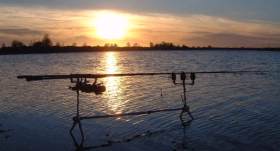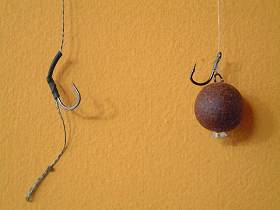|
|
| |
Rik started fishing at the age of four on his local tiny tidal river, catching eels and small wild trout on worm.
Not having had any angling family members, all his early fishing was solitary and this seems to have carried through to the present.
Like most anglers nowadays, he has a full time job and a family, so his fishing time is limited, although he does, he tells us, have a very understanding wife.He currently lives in the depths of Hampshire, and so is within easy reach of some excellent venues.
He has in the past, and still does, fish for most species, although his greatest love is for carp fishing, which is how the majority of his time is spent.
He now finds himself more thrilled with overcoming the intricacies and problems associated with catching carp, rather than the actual weight of the fish he catches and the so-called glory that goes with it.
Short Session Winter Carping
With the onset of the winter months it is very easy to lose the appetite for carping that keeps us so hungry and dedicated through the warmer parts of the year.
It seems so much easier to go piking, chubbing on the river, or in some cases, stay indoors and do that little DIY job you’ve been putting off since April.
Being cold, wet and miserable for a couple of days at a bleak looking gravel pit is certainly not my idea of fun, so how can we maximise our chances when fishing short sessions?
Take the minimum gear that I can get away with to begin with. You can certainly do without your cooking equipment, so take a flask. You don’t need buckets of particles and pellets neither when a tub of hookbaits and a small bag of freebies should suffice.
Do you get the idea?
Cut down on your gear, it will make you more mobile and more willing to move, which leads on nicely to one of my major rules when winter carping.
If you see a carp………..get on it!
Carp don’t tend to show much in the winter, it may only be a flat spot on an otherwise rippling surface or a quiet head and shouldering, but if you do see something, put a bait there. But don’t expect a take within minutes. It could be a few hours later, so unless you see something else to make you recast, then leave it there.
|
|
| |
Personally, I have found this to be complete rubbish.
I had over 60 carp from one particular water I used to fish, all between November and March, and still couldn’t figure any set feeding times. When they fed I would often get two or three fish in quick succession during a feeding spell that lasted about half to three quarters of an hour. But this could have been, and frequently was, at different times. Which leads to another important point.
If you get a fish, get your bait back out quickly – that feeding spell may be very short.
Hot spots
During the summer a carp will browse and feed in almost any area. In winter, feeding spots tend to be very localised. I have found that holding areas and feeding spots tend to be separate. The fish will stay in an area and then move to another area to feed. You may pick up an occasional fish from the holding areas, but I have found that the fish group very tightly in these spots and are almost stationary for long periods and quite often at some illogical depth. Some fish will then move out of the holding area and move to, not always directly, a feeding area.
I have tried every conceivable ploy to tempt fish from these holding areas.
– Actually in the zone.
– On their way out.
– On their way back in.
Mostly with no joy.
But find the feeding areas and you’re onto a winner.
So where are the feeding areas? If only it was that simple…….
All lakes are different, and the same lake can have several different spots that are all different in make-up. An example of which is a small pit I fish. I found four distinct winter feeding areas.
The lake is very weedy for most of the year, at about 9 feet deep with a central bar and various lilies, snag trees, gravel patches etc, etc. The four spots are as follows:
A 3 ft deep gravel plateaux.
A 10ft long section of the central bar (no takes anywhere else on the bar).
A 20 yard length of margin on one bank (this bank is uniformly 8 ft deep, 400 yards long with no special features).
An area of no particular note, in the middle of the lake, about 5 ft square.
Why these four particular spots?
I don’t know!!!!!
Have I found similar spots on other lakes? Only similar in the fact that they don’t make sense.
How can I find the spots on my lake? Trial and error, talking, watching, fishing.
Winter carping isn’t easy, but it sure is satisfying when it works.
Bait
In my experience, bait is not the biggest part of the winter jigsaw, although it is very important. With the carp feeding less aggressively and less often, you have to give them something that they want to eat. I could now go on about the baiting campaign and the nutritional milk protein bait that you’ve been applying since September.
Reality usually states otherwise.
Most of us haven’t got the time, money or inclination to put £ 30 a week of bait into a lake. So how does the average angler maximise his/her winter chances?
Single, over-flavoured baits have often been quoted as a winter option. I don’t deny that it is successful, but I’ve not found it to be the best option all winter long.
Early and late, I’ve found it to be as good as other methods, but during late December through to February, I’ve found that it lacks consistency.
I believe that over-flavoured baits pick up cruising fish and during the coldest months the carp simply don’t move enough to find them, except on clear bright days when the sun can warm up parts of the lake and make the carp move. I find that the best approach for the majority of the winter is to set little bait traps. Just enough for a little snack.
This obviously depends on the size and numbers of fish present and could be somewhere between two and 50 freebies. Trickle feeding bait before fishing will greatly increase your chances, two or three times for the week before fishing may well be enough, but two important points…
Firstly, try and make sure that your bait is being eaten and secondly, try to use a bait that is digestible. A carbohydrate based ready-made boilie will just sit heavily in the carp’s gut and may take several days to break down. This will leave them bloated and unwilling to feed.
My main winter approach will normally centre around hemp and maggots. Dripping in a half pouch of hemp and 30 to 50 maggots every 15 to 30 minutes. Providing you are on a water where the silver fish activity is not great, then this has been a particularly good winter method for me.
Rigs
My winter rigs are kept reasonably simple. The main factor determining my rig choice is the bait used, bottom make-up, available snags, weed, etc. It is a fact that the finer you fish then the more bites you will get. This is usually easier to accomplish in the winter when most weed beds and lily pads have died down. Eight to 10lb mono or braid and a size 8 hook will allow a bait to act more naturally than 25lb braid and a size 4.
|
|
| |
The two rigs pictured are my most used winter rigs and allow for fishing over clean gravel or bottom debris/silt depending on where the fish are.
My terminal set-up will vary dependent on the weather and the lakebed in front of me. If it’s very cold, with frosts, clear skies and little wind then it’s likely that I’ll fish a running lead, a flying backlead and light indicators on slack lines, but this may need to be tuned depending on the distance fished, bottom contours, undertow etc.
If the weather is mild, with warmish winds and cloud cover, then I’ll probably fish with a semi-fixed lead, leadcore etc. Note that I don’t fish with leadcore and running leads as I’ve not managed to convince myself that they work as they should or as I want them to.
It may be cold, it may be wet, but once again that overwhelming sense of achievement when that carp slips over the net cord with its glorious winter livery being picked out by the low weak winter sun makes it all worthwhile.













